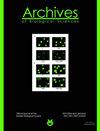Application of an intermediate concentration of cyclophosphamide does not specifically deplete regulatory T cells in a mouse experimental model
IF 0.8
4区 生物学
Q4 BIOLOGY
引用次数: 0
Abstract
Cyclophosphamide (CP) is a cytostatic, widely used to treat different carcinomas and autoimmune diseases. It is commonly used in experimental designs modeling immunosuppression in laboratory animals, with different approaches for CP treatment but without a consensus on the dose, timing, and route of administration. We aimed to establish if treatment with CP in C57BL/6 mice depletes regulatory T cells (Tregs). Tregs are a crucial component of the immune system that helps maintain immune tolerance and prevent excessive immune reactions. They are significant in autoimmune diseases, allergies, and immune-related therapies. CP was applied intraperitoneally (i.p.) twice in a 5-day interval in doses of 100 mg/kg. Monitoring of Treg prevalence in peripheral blood after each treatment and in the spleen after the second treatment with CP revealed a drop in the number of Tregs after two doses of CP because of the decreased number of total lymphocytes but not as a specific response of the Tregs. The prevalence of Tregs in peripheral blood after CP treatment mirrored the change in Treg number in the spleen. CP treatment induced a decrease in the number of CD3+ cells in the spleen while increasing their proportion, indicating that CP affected the B lymphocyte population rather than T cells. Our results suggest that CP treatment cannot be used as a specific Treg-depleting agent in the C57BL/6 animal model.在小鼠实验模型中,应用中等浓度的环磷酰胺不会特异性地耗尽调节性T细胞
环磷酰胺(Cyclophosphamide, CP)是一种细胞抑制剂,广泛用于治疗各种肿瘤和自身免疫性疾病。它通常用于实验动物免疫抑制模型的实验设计,有不同的CP治疗方法,但在剂量、时间和给药途径上没有共识。我们的目的是确定用CP治疗C57BL/6小鼠是否会消耗调节性T细胞(Tregs)。treg是免疫系统的重要组成部分,有助于维持免疫耐受和防止过度的免疫反应。它们在自身免疫性疾病、过敏和免疫相关治疗中具有重要意义。CP以100mg /kg的剂量腹腔注射(i.p.) 2次,间隔5天。对每次治疗后外周血和第二次CP治疗后脾脏Treg患病率的监测显示,两次剂量CP后Treg数量下降,这是由于总淋巴细胞数量减少,但不是Treg的特异性反应。CP治疗后外周血Treg的流行反映了脾脏Treg数量的变化。CP处理导致脾脏中CD3+细胞数量减少,但比例增加,表明CP影响的是B淋巴细胞群而不是T细胞。我们的结果表明,在C57BL/6动物模型中,CP治疗不能作为特异性treg消耗剂。
本文章由计算机程序翻译,如有差异,请以英文原文为准。
求助全文
约1分钟内获得全文
求助全文
来源期刊
CiteScore
1.40
自引率
0.00%
发文量
25
审稿时长
3-8 weeks
期刊介绍:
The Archives of Biological Sciences is a multidisciplinary journal that covers original research in a wide range of subjects in life science, including biology, ecology, human biology and biomedical research.
The Archives of Biological Sciences features articles in genetics, botany and zoology (including higher and lower terrestrial and aquatic plants and animals, prokaryote biology, algology, mycology, entomology, etc.); biological systematics; evolution; biochemistry, molecular and cell biology, including all aspects of normal cell functioning, from embryonic to differentiated tissues and in different pathological states; physiology, including chronobiology, thermal biology, cryobiology; radiobiology; neurobiology; immunology, including human immunology; human biology, including the biological basis of specific human pathologies and disease management.

 求助内容:
求助内容: 应助结果提醒方式:
应助结果提醒方式:


